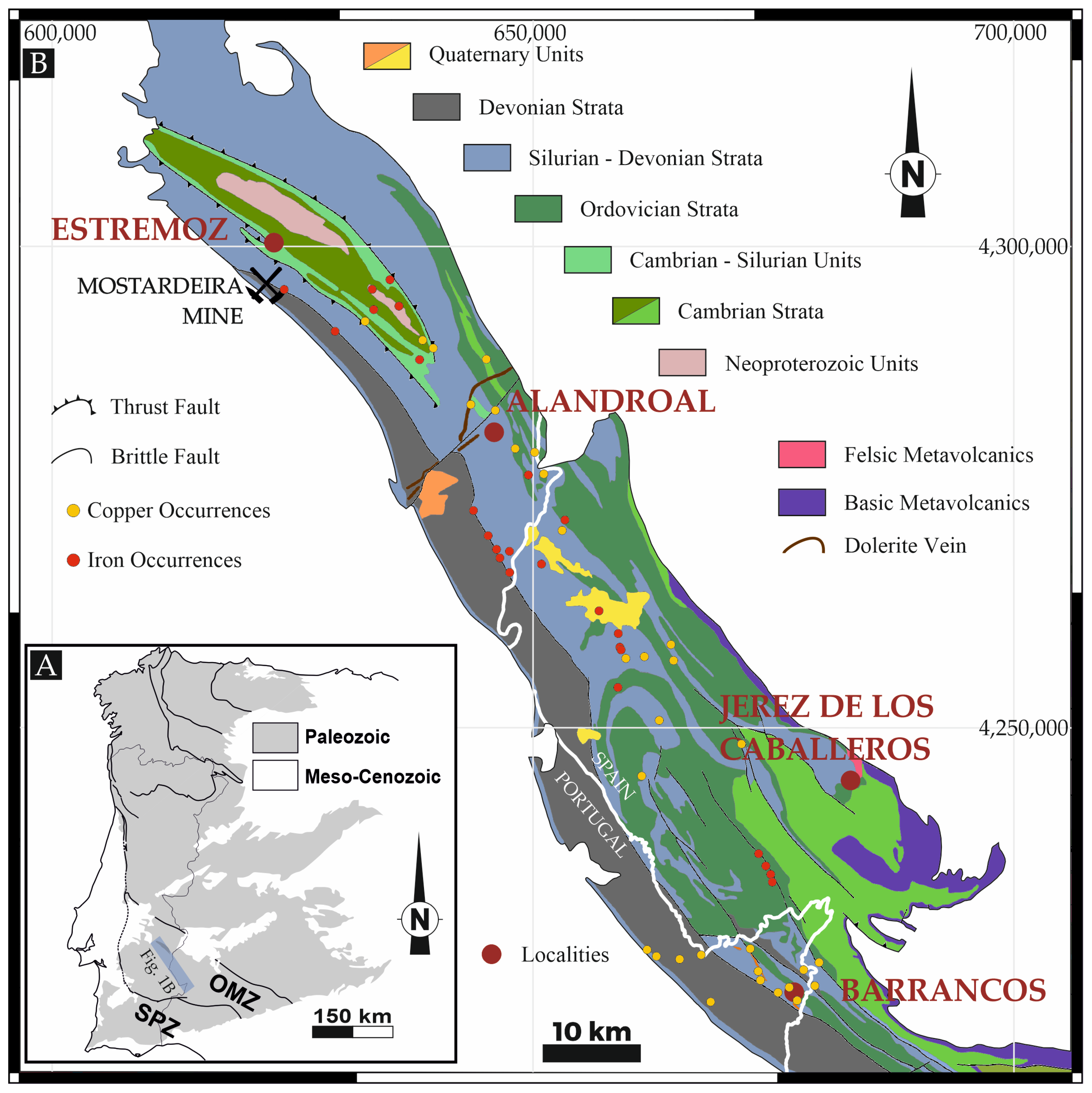Mapping the Mine: Combining Portable X-ray Fluorescence, Spectroradiometry, UAV, and Sentinel-2 Images to Identify Contaminated Soils—Application to the Mostardeira Mine (Portugal)
Abstract
1. Introduction
2. Geological and Mining Background
3. Materials and Methods
3.1. Field Data Collection
3.2. Portable X-ray Fluorescence (pXRF)
3.3. Field Spectroradiometry
3.4. Sentinel 2 Satellite Data
3.5. Multispectral Drone Data
3.6. Data Processing
3.7. Soil Use (SU) Types and Land Cover (LC)
4. Results
4.1. Portable XRF
4.1.1. Exploratory Data Analysis
4.1.2. Principal Components Analysis
4.1.3. K-Means Clustering
4.2. Optical Spectroradiometry
4.2.1. Exploratory Data Analysis
4.2.2. Principal Components Analysis
4.3. Sentinel-2
4.3.1. Sentinel-2 Band Compositions
4.3.2. Sentinel-2 Band Ratios
4.3.3. Principal Components Analysis
4.4. Drone Images
4.4.1. Band Composition and Band Ratios
4.4.2. Principal Components Analysis
4.4.3. Classification Algorithms
5. Discussion
5.1. Portable XRF
5.2. Optical Spectroradiometry
5.3. Sentinel-2 Images
5.4. Drone Images
6. Conclusions
- The ground techniques identified the presence of contaminated soils (e.g., As and Cu) with values of metals that are in concentrations higher than those recommended by the Portuguese environmental agency.
- Airborne—i.e., drone and satellite images—allowed us to map the different types of land cover in the study area, revealing the limited geographic distribution of the contaminated soils.
- The interpolation of ground data does not allow the mapping of the total extent of the contaminated area, but a combination of this approach with drone and satellite images reveals that this is in a limited area, and can certainly be remediated.
- The multidisciplinary methodological approach has proved to be successful in identifying not only the environmental problem, but also characterizing its cartographic distribution.
- The integration of statistical methods with machine learning and artificial intelligence techniques constitutes a valued way to gain additional insights into understanding factors that play a significant role in diverse natural and anthropogenic processes, whether they have a chemical or physical nature.
Supplementary Materials
Author Contributions
Funding
Data Availability Statement
Acknowledgments
Conflicts of Interest
References
- Pardo Abad, C.J. Environmental Recovery of Abandoned Mining Areas in Spain: Sustainability and New Landscapes in Some Case Studies. J. Sustain. Res. 2019, 1, e190003. [Google Scholar] [CrossRef]
- Sinnett, D.E.; Sardo, A.M. Former Metal Mining Landscapes in England and Wales: Five Perspectives from Local Residents. Landsc. Urban. Plan. 2020, 193, 103685. [Google Scholar] [CrossRef]
- Kuter, N. Reclamation of Degraded Landscapes Due to Opencast Mining. In Advances in Landscape Architecture; Intech Open: London, UK, 2013. [Google Scholar] [CrossRef]
- Fazle Bari, A.S.M.; Lamb, D.; MacFarlane, G.R.; Rahman, M.M. Soil Washing of Arsenic from Mixed Contaminated Abandoned Mine Soils and Fate of Arsenic after Washing. Chemosphere 2022, 296, 134053. [Google Scholar] [CrossRef]
- Pelica, J.; Barbosa, S.; Reboredo, F.; Lidon, F.; Pessoa, F.; Calvão, T. The Paradigm of High Concentration of Metals of Natural or Anthropogenic Origin in Soils—The Case of Neves-Corvo Mine Area (Southern Portugal). J. Geochem. Explor. 2018, 186, 12–23. [Google Scholar] [CrossRef]
- Huang, Y.C.; Huang, C.Y.; Minasny, B.; Chen, Z.S.; Hseu, Z.Y. Using PXRF and Vis-NIR for Characterizing Diagnostic Horizons of Fine-Textured Podzolic Soils in Subtropical Forests. Geoderma 2023, 437, 116582. [Google Scholar] [CrossRef]
- Nogueira, P.; Vicente, S.; Maia, M.; Roseiro, J.; Nogueira, P.; Vicente, S.; Maia, M. High Resolution Geochemical Mapping in the Mociços Mine (Ossa-Morena Zone, Portugal). Contributes from Machine Learning Methods. Comun. Geológicas 2020, 107, 55–62. [Google Scholar]
- Lemière, B.; Melleton, J.; Auger, P.; Derycke, V.; Gloaguen, E.; Bouat, L.; Mikšová, D.; Filzmoser, P.; Middleton, M. PXRF Measurements on Soil Samples for the Exploration of an Antimony Deposit: Example from the Vendean Antimony District (France). Minerals 2020, 10, 724. [Google Scholar] [CrossRef]
- Lemière, B. A Review of PXRF (Field Portable X-ray Fluorescence) Applications for Applied Geochemistry. J. Geochem. Explor. 2018, 188, 350–363. [Google Scholar] [CrossRef]
- Nogueira, P.; Afonso, P.; Roseiro, J.; Maia, M.; São Pedro, D.; Moreira, N.; Matos, J.X.; Batista, M.J. Portable X-ray Fluorescence and Clustering Methods Applied to Mineral Exploration: The Significance and Nature of Batigelas Anomaly (Ossa-Morena Zone-Cabeço de Vide, Portugal). Comun. Geológicas 2020, 107, 47–53. [Google Scholar]
- Zhou, S.; Wang, J.; Wang, W.; Liao, S. Evaluation of Portable X-ray Fluorescence Analysis and Its Applicability As a Tool in Geochemical Exploration. Minerals 2023, 13, 166. [Google Scholar] [CrossRef]
- Purwadi, I.; van der Werff, H.; Lievens, C. Reflectance Spectroscopy and Geochemical Analysis of Rare Earth Element-Bearing Tailings: A Case Study of Two Abandoned Tin Mine Sites in Bangka Island, Indonesia. Int. J. Appl. Earth Obs. Geoinf. 2019, 74, 239–247. [Google Scholar] [CrossRef]
- Cull, S.; Cravotta, C.A.; Klinges, J.G.; Weeks, C. Spectral Masking of Goethite in Abandoned Mine Drainage Systems: Implications for Mars. Earth Planet. Sci. Lett. 2014, 403, 217–224. [Google Scholar] [CrossRef]
- Zhao, D.; Xie, D.; Yin, F.; Liu, L.; Feng, J.; Ashraf, T. Estimation of Pb Content Using Reflectance Spectroscopy in Farmland Soil Near Metal Mines, Central China. Remote. Sens. 2022, 14, 2420. [Google Scholar] [CrossRef]
- Guo, B.; Zhang, B.; Su, Y.; Zhang, D.; Wang, Y.; Bian, Y.; Suo, L.; Guo, X.; Bai, H. Retrieving Zinc Concentrations in Topsoil with Reflectance Spectroscopy at Opencast Coal Mine Sites. Sci. Rep. 2021, 11, 19909. [Google Scholar] [CrossRef] [PubMed]
- Lamine, S.; Pandey, M.K.; Petropoulos, G.P.; Brewer, P.A.; Srivastava, P.K.; Manevski, K.; Toulios, L.; Bachari, N.-E.-I.; Macklin, M.G. Spectroradiometry as a Tool for Monitoring Soil Contamination by Heavy Metals in a Floodplain Site. Hyperspectral Remote Sens. 2020, 249–268. [Google Scholar] [CrossRef]
- Frutuoso, R.; Lima, A.; Teodoro, A.C. Application of Remote Sensing Data in Gold Exploration: Targeting Hydrothermal Alteration Using Landsat 8 Imagery in Northern Portugal. Arab. J. Geosci. 2021, 14, 459. [Google Scholar] [CrossRef]
- Alarifi, S.S.; Abdelkareem, M.; Abdalla, F.; Abdelsadek, I.S.; Gahlan, H.; Al-Saleh, A.M.; Alotaibi, M. Fusion of Multispectral Remote-Sensing Data through GIS-Based Overlay Method for Revealing Potential Areas of Hydrothermal Mineral Resources. Minerals 2022, 12, 1577. [Google Scholar] [CrossRef]
- Hu, B.; Xu, Y.; Wan, B.; Wu, X.; Yi, G. Hydrothermally Altered Mineral Mapping Using Synthetic Application of Sentinel-2A MSI, ASTER and Hyperion Data in the Duolong Area, Tibetan Plateau, China. Ore Geol. Rev. 2018, 101, 384–397. [Google Scholar] [CrossRef]
- Mielke, C.; Boesche, N.K.; Rogass, C.; Kaufmann, H.; Gauert, C.; de Wit, M. Spaceborne Mine Waste Mineralogy Monitoring in South Africa, Applications for Modern Push-Broom Missions: Hyperion/OLI and EnMAP/Sentinel-2. Remote Sens. 2014, 6, 6790–6816. [Google Scholar] [CrossRef]
- Quental, L.; Gonçalves, P.; De Oliveira, D.; Batista, M.J.; Matos, J.X.; Sousa, A.J.; Marsh, S.; Carreiras, J.; Dias, R. Multispectral and Hyperspectral Remote Sensing as a Source of Knowledge in the Portuguese Sector of the Iberian Pyrite Belt. Comun. Geológicas 2020, 107, 21–39. [Google Scholar]
- Matos, J.X.; Rosa, C. Diagnóstico Preliminar de Minas Abandonadas—Área Sul; IGM: Lisbon, Portugal, 2001. [Google Scholar]
- Mateus, A.; Munhá, J.; Inverno, C.; Matos, J.X.; Martins, L.; Oliveira, D.; Jesus, A.; Salgueiro, R. Mineralizações No Sector Português Da Zona de Ossa Morena. In Geologia de Portugal; Dias, R., Araújo, A., Terrinha, P., Kullberg, J.C., Eds.; Escolar Editora: Lisboa, Portugal, 2013; Volume 1, pp. 577–619. [Google Scholar]
- Albardeiro, L.; Morais, I.; Matos, J.X.; Solá, R.; Salgueiro, R.; Pereira, Z.; Mendes, M.; Batista, M.J.; de Oliveira, D.; Díez-Montes, A.; et al. Time-Space Evolution of Iberian Pyrite Belt Igneous Activity: Volcanic and Plutonic Lineaments, Geochronology, Ore Horizons and Stratigraphic Constraints. Gondwana Res. 2023, 121, 235–258. [Google Scholar] [CrossRef]
- Brandão, J.; Matos, J.X. Memória do cobre. Nota sobre a criação de um parque arqueo-indústrial na Mina da Herdade da Mostardeira (Estremoz, Portugal). In Proceedings of the Primer Simpósio sobre la Minería y la Metalurgie Antigua en el SW Europeo, Serós, Spain, 5–7 May 2000; pp. 427–437. [Google Scholar]
- Fernandes, G.P. Mineralizações de Cobre Da Mina de Miguel Vacas: Caracterização Petrográfica e Geoquímica. Ph.D. Thesis, Faculdade de Ciências da Universidade de Lisboa, Lisboa, Portugal, 2012. [Google Scholar]
- Lotze, F. Zur Gliederung Der Varisziden Der Iberischen Meseta. Geotekt. Forschg. 1945, 6, 78–92. [Google Scholar]
- Araújo, A.; Piçarra Almeida, J.; Borrego, J.; Pedro, J.; Oliveira, T. As regiões Central e Sul da Zona de Ossa-Morena. In Geologia de Portugal; Dias, R., Araújo, A., Terrinha, P., Kullberg, J.C., Eds.; Escolar Editora: Lisboa, Portugal, 2013; Volume 1. [Google Scholar]
- QGIS Development Team. QGIS Geographic Information System, version 3.32; QGIS Development Team, 2023. [Google Scholar]
- R Core Team. R: A Language and Environment for Statistical Computing; R Core Team: Vienna, Austria, 2023. [Google Scholar]
- Spectroradiometer User Manual ASD FieldSpec ® HandHeld 2 TM Spectroradiometer User Manual; ASD: Longmont, CO, USA, 2017.
- Cardoso-Fernandes, J.; Teodoro, A.C.; Lima, A.; Perrotta, M.; Roda-Robles, E. Detecting Lithium (Li) Mineralizations from Space: Current Research and Future Perspectives. Appl. Sci. 2020, 10, 1785. [Google Scholar] [CrossRef]
- Guglietta, D.; Conte, A.M.; Paciucci, M.; Passeri, D.; Trapasso, F.; Salvatori, R. Mining Residues Characterization and Sentinel-2A Mapping for the Valorization and Efficient Resource Use by Multidisciplinary Strategy. Minerals 2022, 12, 617. [Google Scholar] [CrossRef]
- Isgró, M.A.; Basallote, M.D.; Caballero, I.; Barbero, L. Comparison of UAS and Sentinel-2 Multispectral Imagery for Water Quality Monitoring: A Case Study for Acid Mine Drainage Affected Areas (SW Spain). Remote. Sens. 2022, 14, 4053. [Google Scholar] [CrossRef]
- Hanelli, D.; Barth, A.; Volkmer, G.; Köhler, M. Modelling of Acid Mine Drainage in Open Pit Lakes Using Sentinel-2 Time-Series: A Case Study from Lusatia, Germany. Minerals 2023, 13, 271. [Google Scholar] [CrossRef]
- Henrich, V.; Krauss, G.; Götze, C.; Sandow, C. Entwicklung Einer Datenbank Für Fernerkundungsindizes. Boch. AK Fernerkund. 2012, 4–5+10. Available online: https://www.indexdatabase.de (accessed on 1 September 2023).
- Segal, D. Theoretical Basis for Differentiation of Ferric-Iron Bearing Minerals, Using Landsat MSS Data. In Proceedings of the Symposium for Remote Sensing of Environment, 2nd Thematic Conference on Remote Sensing for Exploratory Geology, Fort Worth, TX, USA, 6 September 1982; pp. 949–951. [Google Scholar]
- Rowan, L.C.; Mars, J.C. Lithologic Mapping in the Mountain Pass, California Area Using Advanced Spaceborne Thermal Emission and Reflection Radiometer (ASTER) Data. Remote Sens. Env. Environ. 2003, 84, 350–366. [Google Scholar] [CrossRef]
- Volesky, J.C.; Stern, R.J.; Johnson, P.R. Geological Control of Massive Sulfide Mineralization in the Neoproterozoic Wadi Bidah Shear Zone, Southwestern Saudi Arabia, Inferences from Orbital Remote Sensing and Field Studies. Precambrian Res. 2003, 123, 235–247. [Google Scholar] [CrossRef]
- Hartigan, J.A.; Wong, M.A. Algorithm AS 136: A K-Means Clustering Algorithm. J. R. Stat. Soc. Ser. C 1979, 28, 100–108. [Google Scholar] [CrossRef]
- Kokaly, R.F.; Clark, R.N.; Swayze, G.A.; Livo, K.E.; Hoefen, T.M.; Pearson, N.C.; Wise, R.A.; Benzel, W.; Lowers, H.A.; Driscoll, R.L.; et al. USGS Spectral Library Version 7; Data Series 1035; USGS: Reston, VA, USA, 2017. [CrossRef]
- Bédard, É.; De Bronac de Vazelhes, V.; Beaudoin, G. Performance of Predictive Supervised Classification Models of Trace Elements in Magnetite for Mineral Exploration. J. Geochem. Explor. 2022, 236, 106959. [Google Scholar] [CrossRef]
- Li, F.; Xu, L.; You, T.; Lu, A. Measurement of Potentially Toxic Elements in the Soil through NIR, MIR, and XRF Spectral Data Fusion. Comput. Electron. Agric. 2021, 187, 106257. [Google Scholar] [CrossRef]
- Rouillon, M.; Taylor, M.P. Can Field Portable X-ray Fluorescence (PXRF) Produce High Quality Data for Application in Environmental Contamination Research? Environ. Pollut. 2016, 214, 255–264. [Google Scholar] [CrossRef] [PubMed]
- Choe, E.; van der Meer, F.; van Ruitenbeek, F.; van der Werff, H.; de Smeth, B.; Kim, K.W. Mapping of Heavy Metal Pollution in Stream Sediments Using Combined Geochemistry, Field Spectroscopy, and Hyperspectral Remote Sensing: A Case Study of the Rodalquilar Mining Area, SE Spain. Remote Sens. Environ. 2008, 112, 3222–3233. [Google Scholar] [CrossRef]
- Abreu, M.M.; Matias, M.J.; Magalhães, M.C.F.; Basto, M.J. Impacts on Water, Soil and Plants from the Abandoned Miguel Vacas Copper Mine, Portugal. J. Geochem. Explor. 2008, 96, 161–170. [Google Scholar] [CrossRef][Green Version]
- Rosado, L. Caracterização Biogeoquímica de Minas Abandonadas: Os casos da Mina de São Domingos e da Mina da Mostardeira. Master’s Thesis, Universidade de Évora, Évora, Portugal, 2009. [Google Scholar]
- Xu, H.; Croot, P.; Zhang, C. Discovering Hidden Spatial Patterns and Their Associations with Controlling Factors for Potentially Toxic Elements in Topsoil Using Hot Spot Analysis and K-Means Clustering Analysis. Environ. Int. 2021, 151, 106456. [Google Scholar] [CrossRef]
- Shand, C.A.; Wendler, R. Portable X-ray Fluorescence Analysis of Mineral and Organic Soils and the Influence of Organic Matter. J. Geochem. Explor. 2014, 143, 31–42. [Google Scholar] [CrossRef]
- Chabrillat, S.; Ben-Dor, E.; Cierniewski, J.; Gomez, C.; Schmid, T.; van Wesemael, B. Imaging Spectroscopy for Soil Mapping and Monitoring. Surv. Geophys. 2019, 40, 361–399. [Google Scholar] [CrossRef]
- Van der Meer, F.D.; van der Werff, H.M.A.; van Ruitenbeek, F.J.A. Potential of ESA’s Sentinel-2 for Geological Applications. Remote Sens. Environ. 2014, 148, 124–133. [Google Scholar] [CrossRef]
- van der Werff, H.; van der Meer, F. Sentinel-2 for Mapping Iron Absorption Feature Parameters. Remote Sens. 2015, 7, 12635–12653. [Google Scholar] [CrossRef]
- Crowley, J.K.; Williams, D.E.; Hammarstrom, J.M.; Piatak, N.; Chou, I.M.; Mars, J.C. Spectral Reflectance Properties (0.4–2.5 Μm) of Secondary Fe-Oxide, Fe-Hydroxide, and Fe-Sulphate-Hydrate Minerals Associated with Sulphide-Bearing Mine Wastes. Geochem. Explor. Environ. Anal. 2003, 3, 219–228. [Google Scholar] [CrossRef]
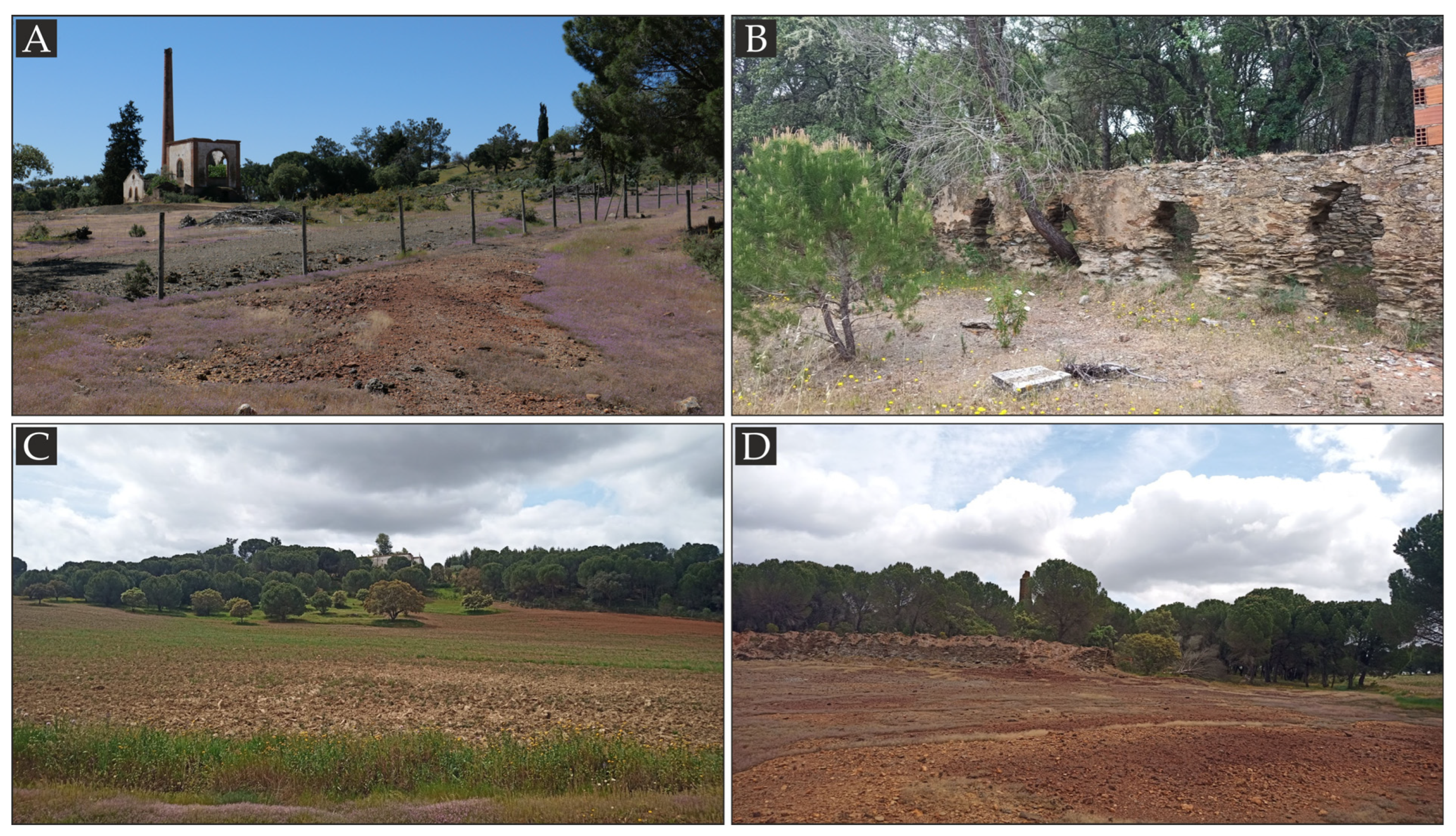

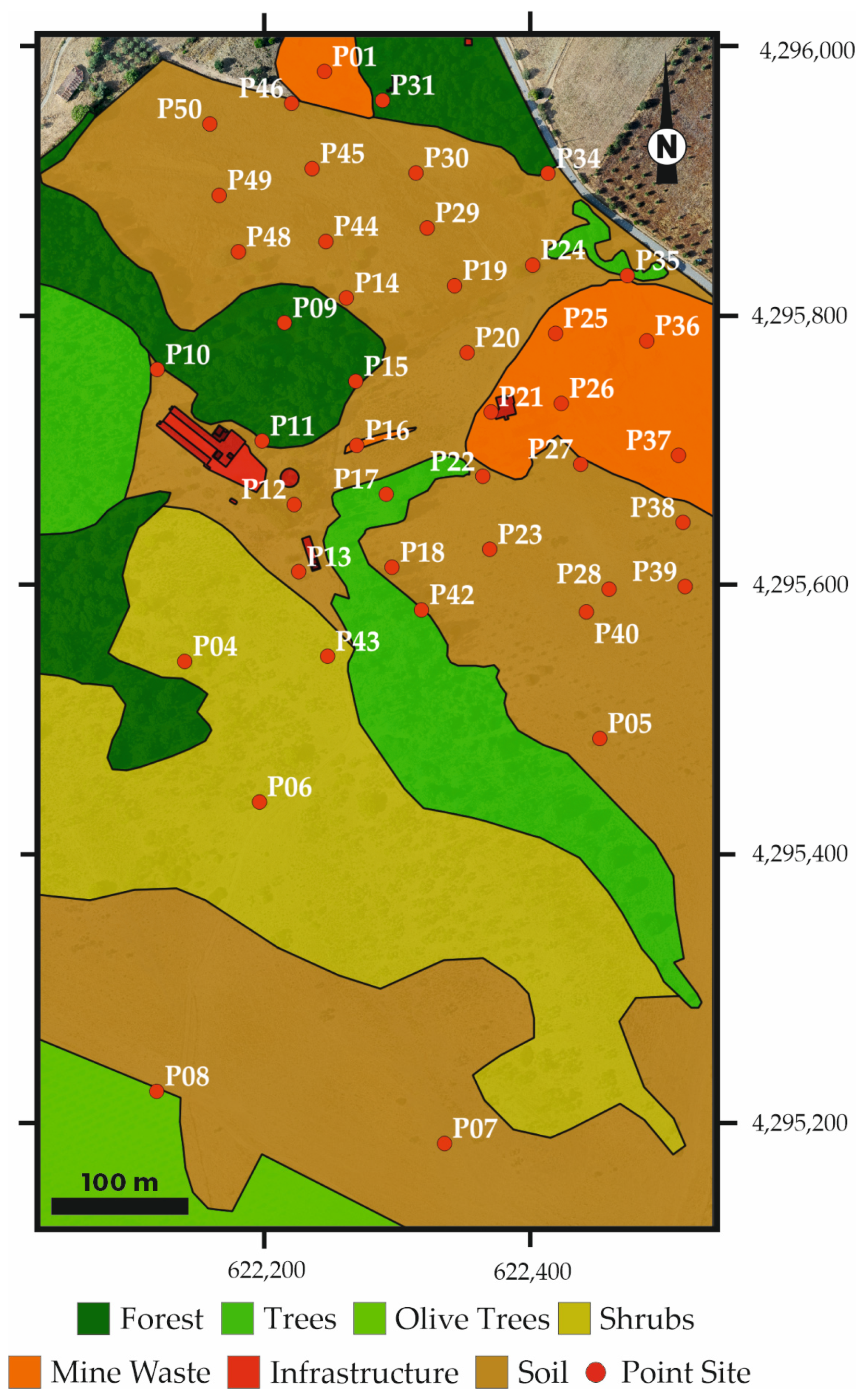
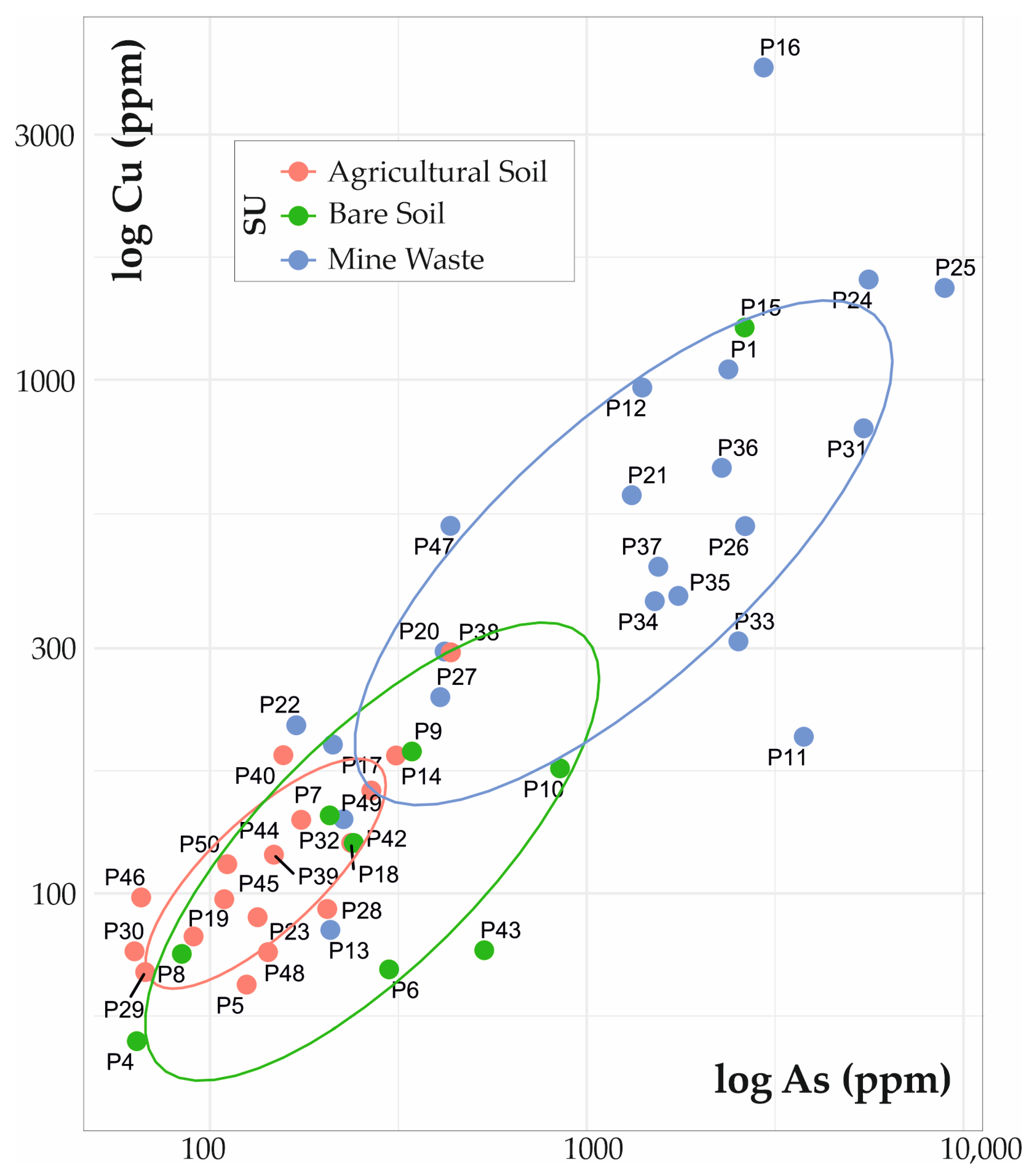
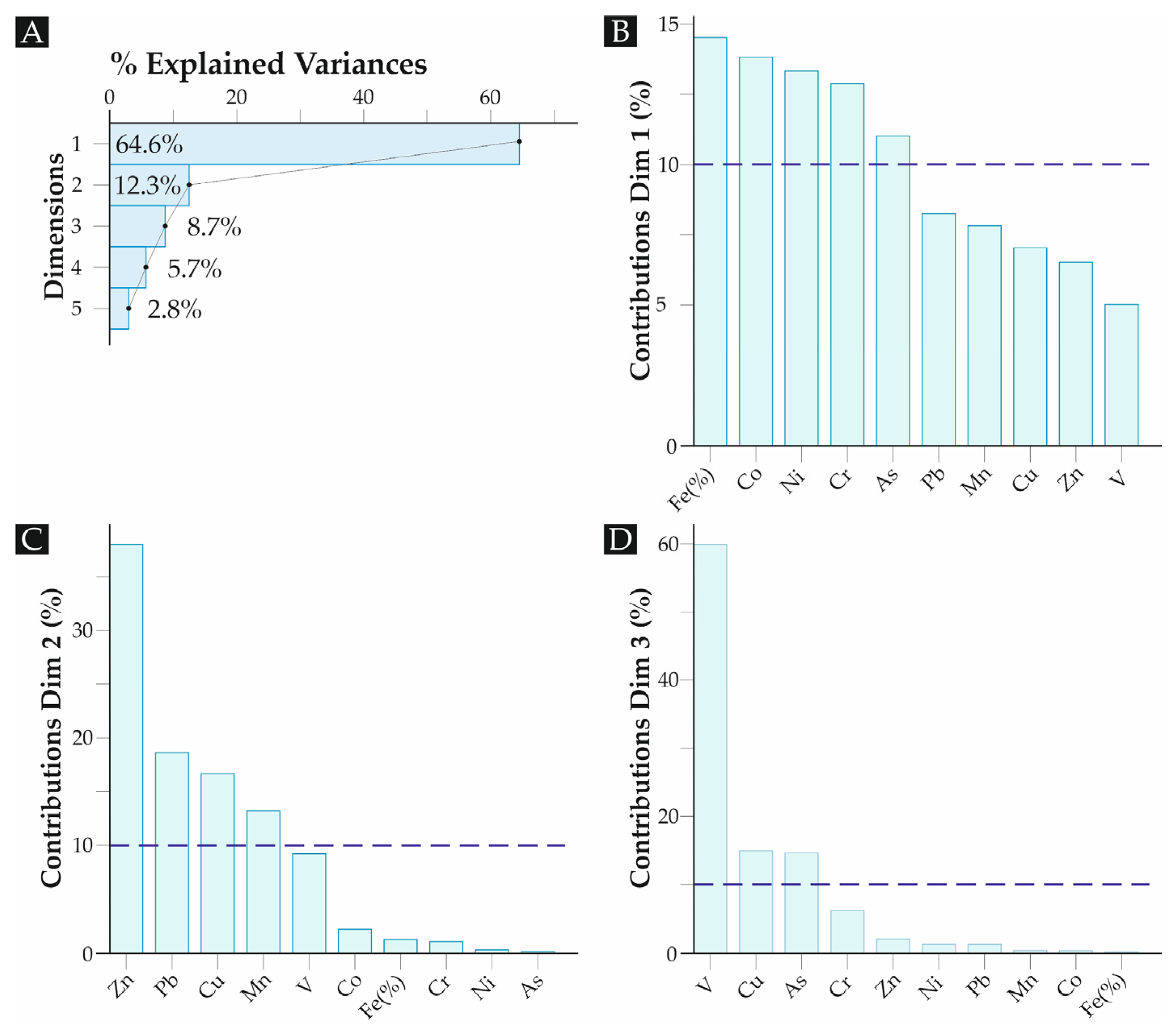

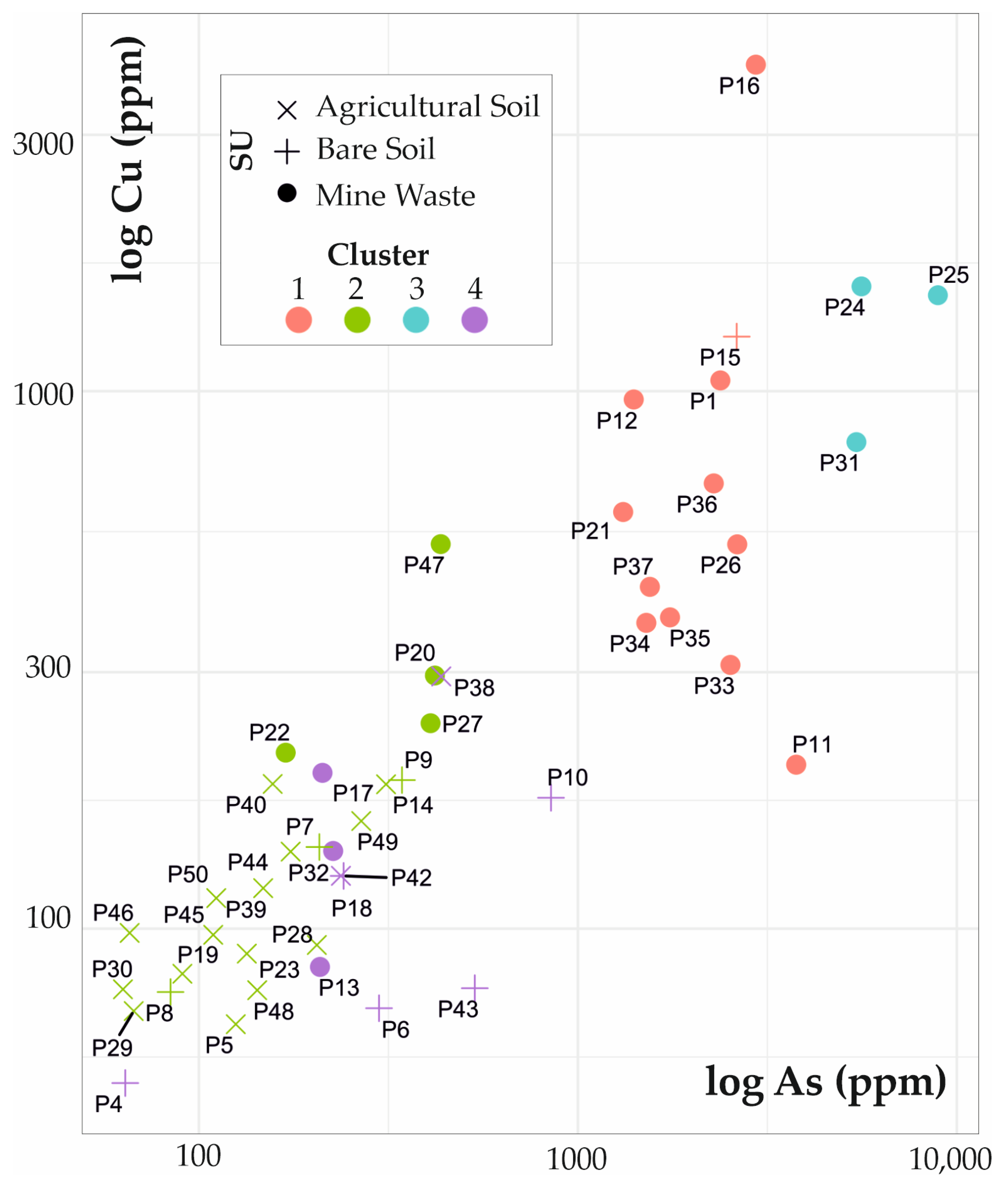
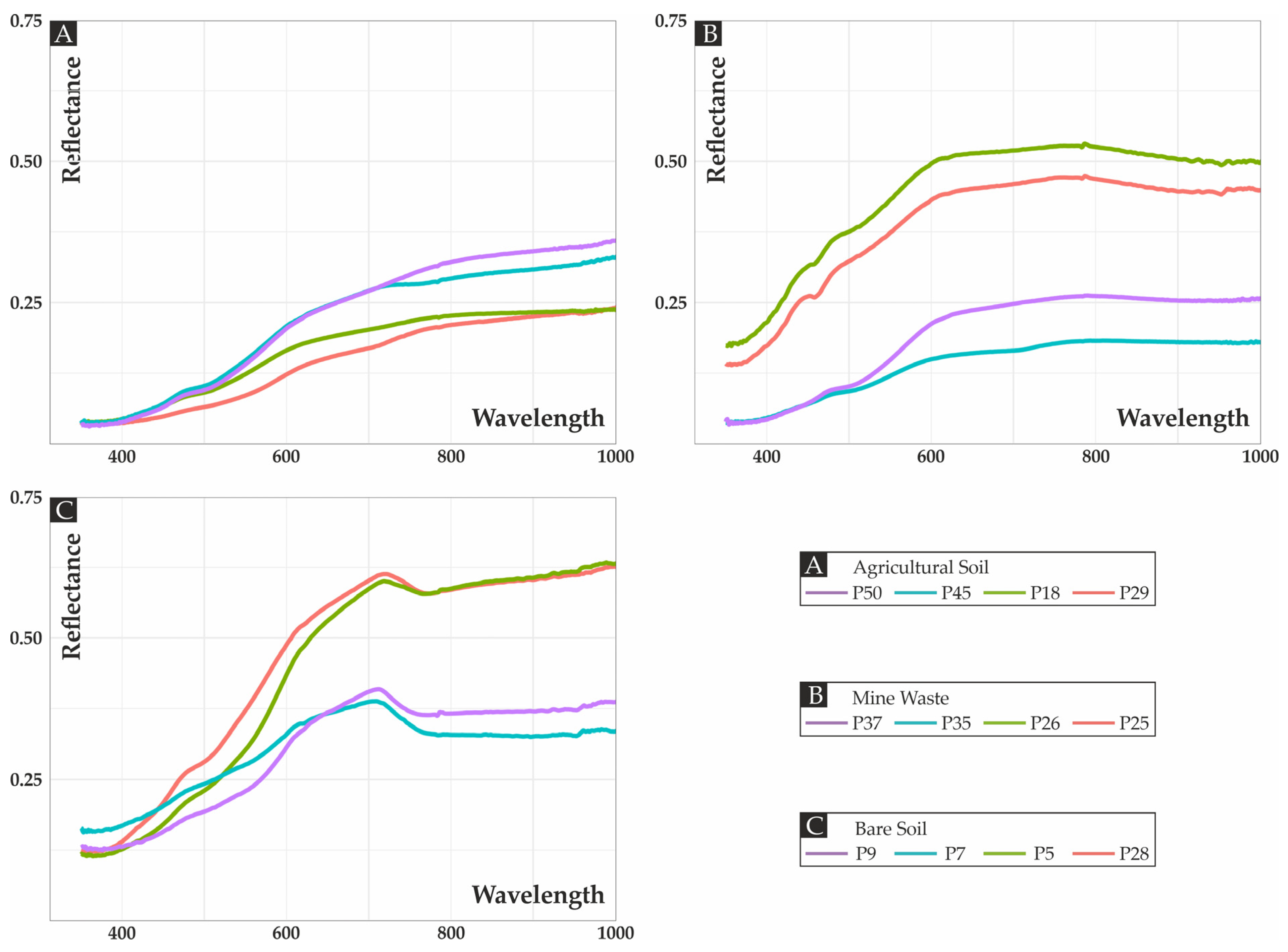
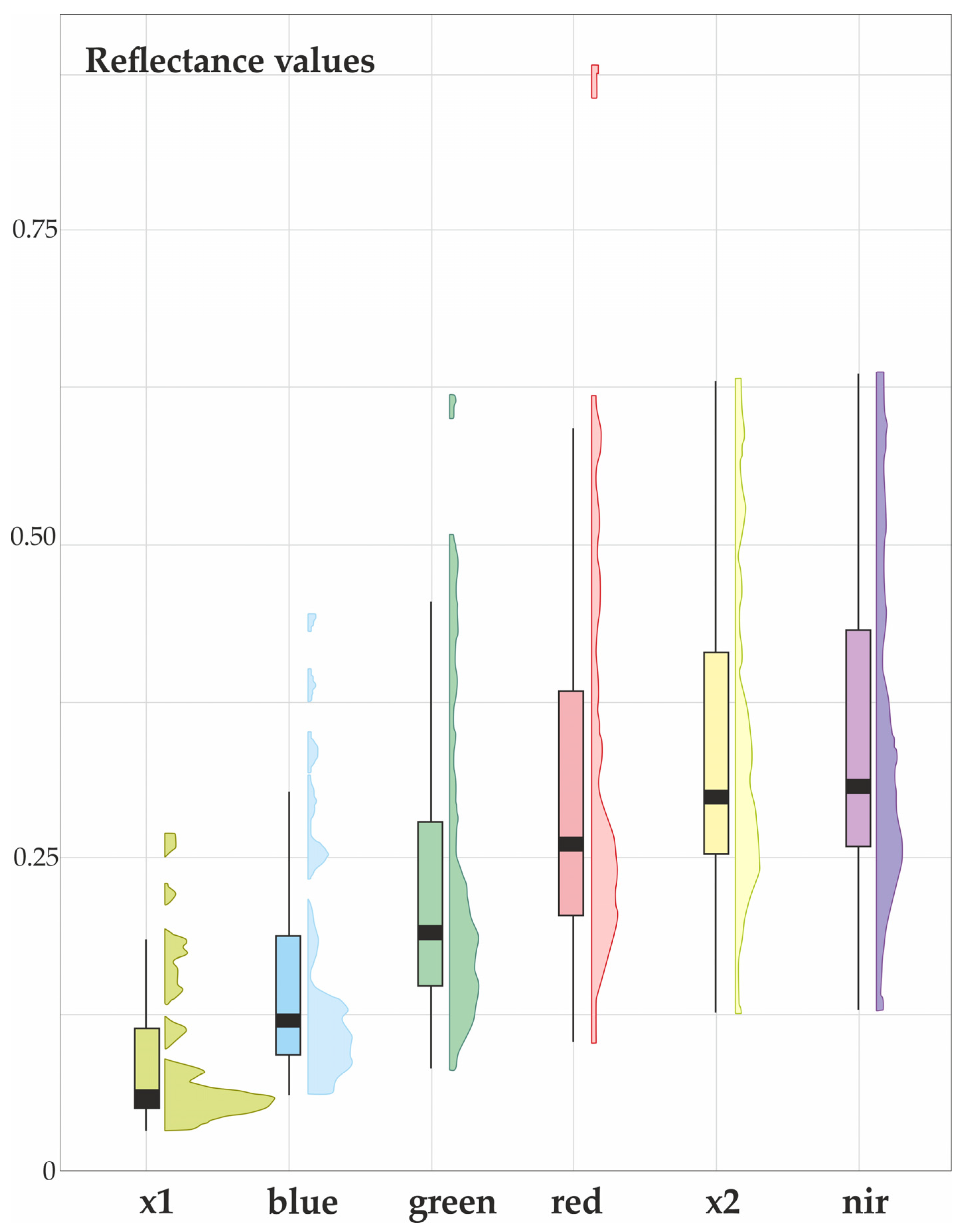
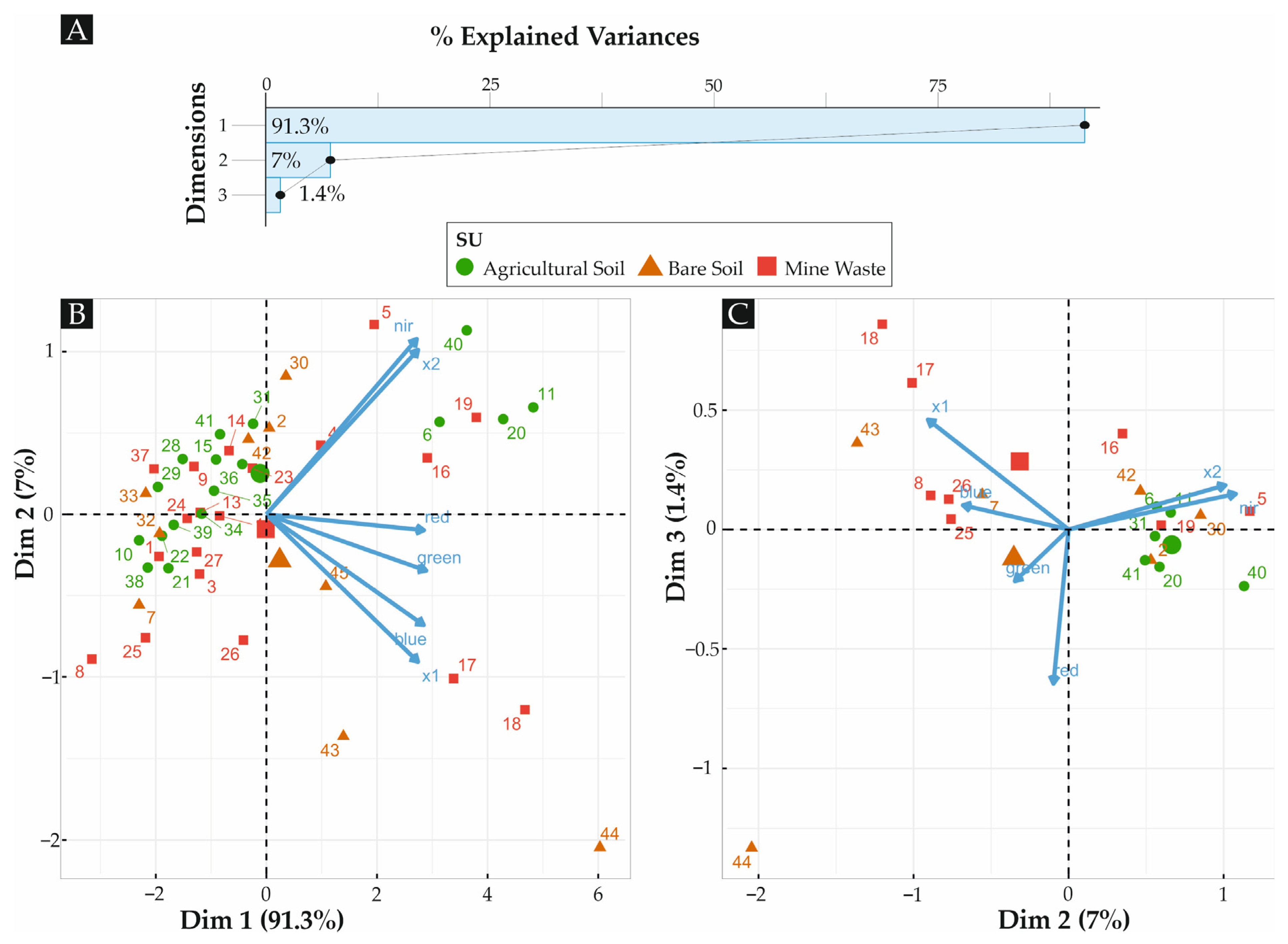
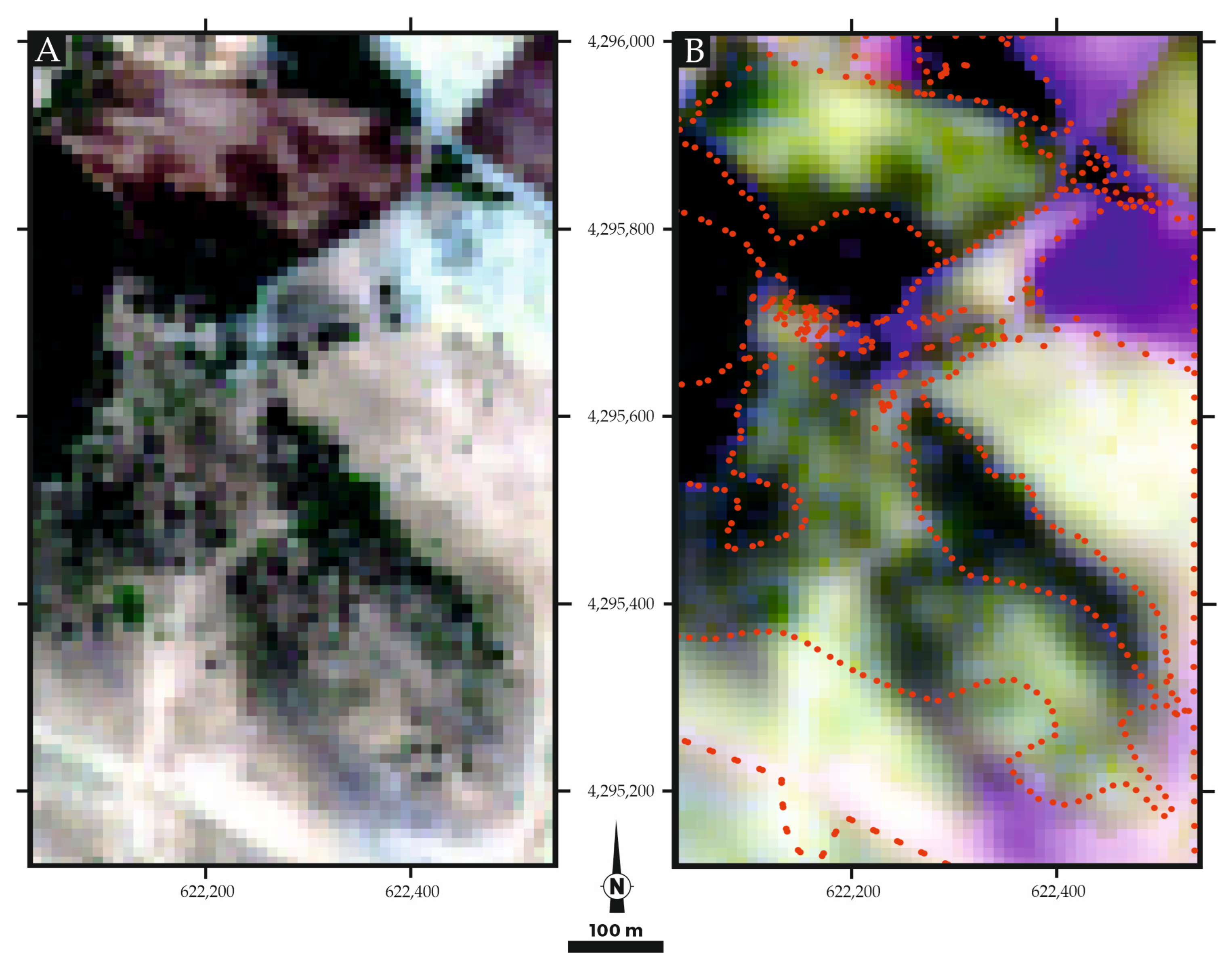
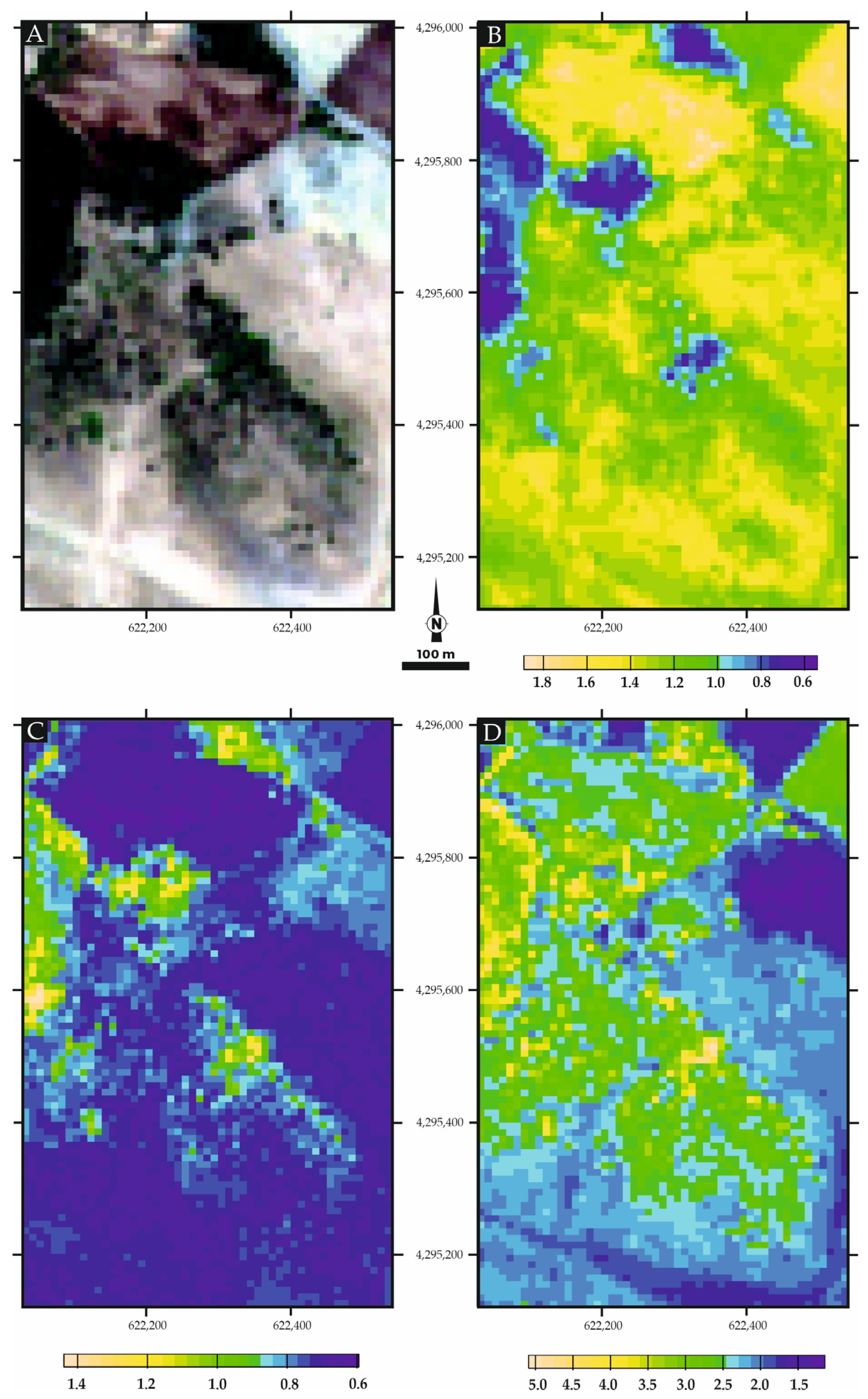
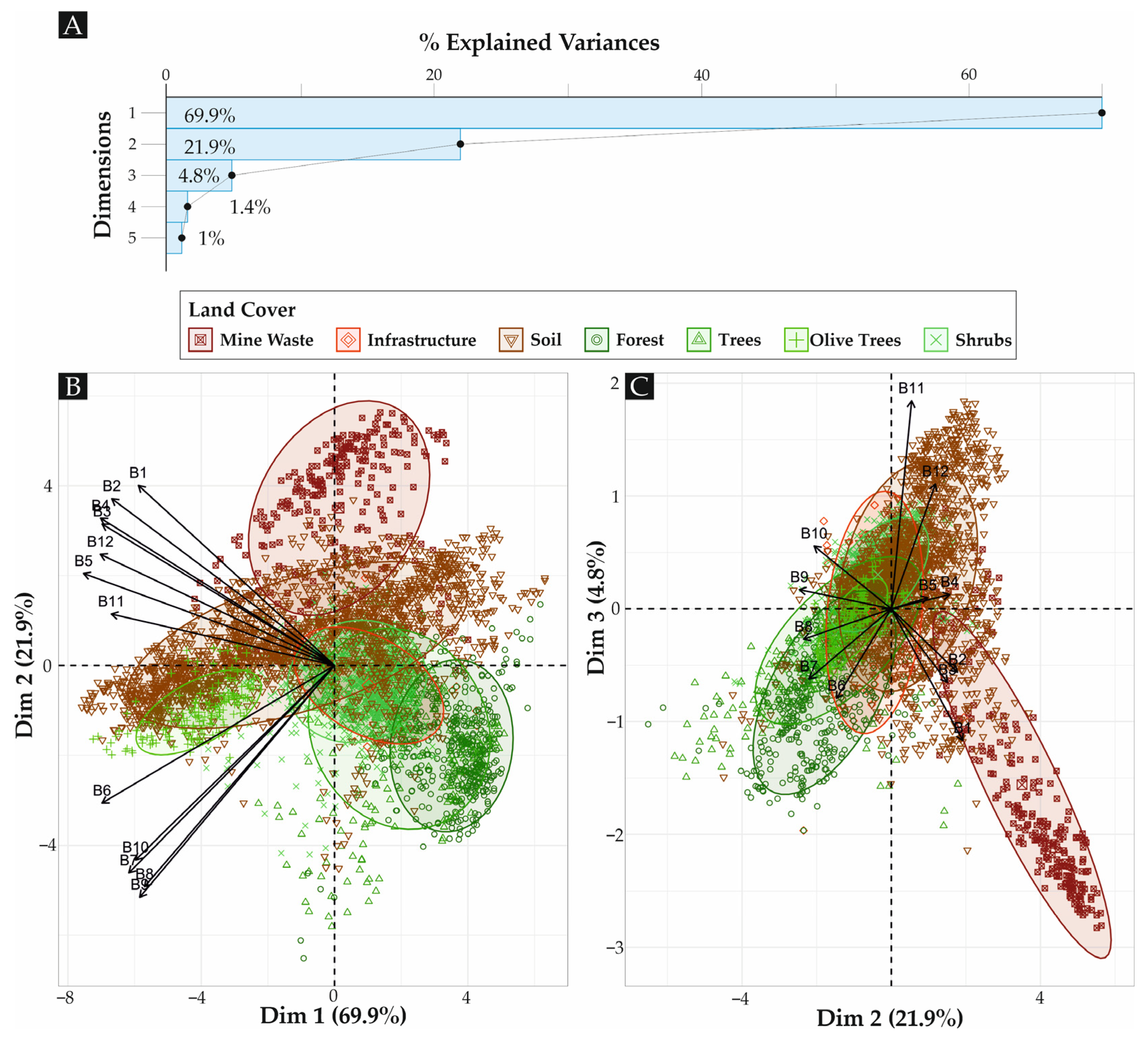
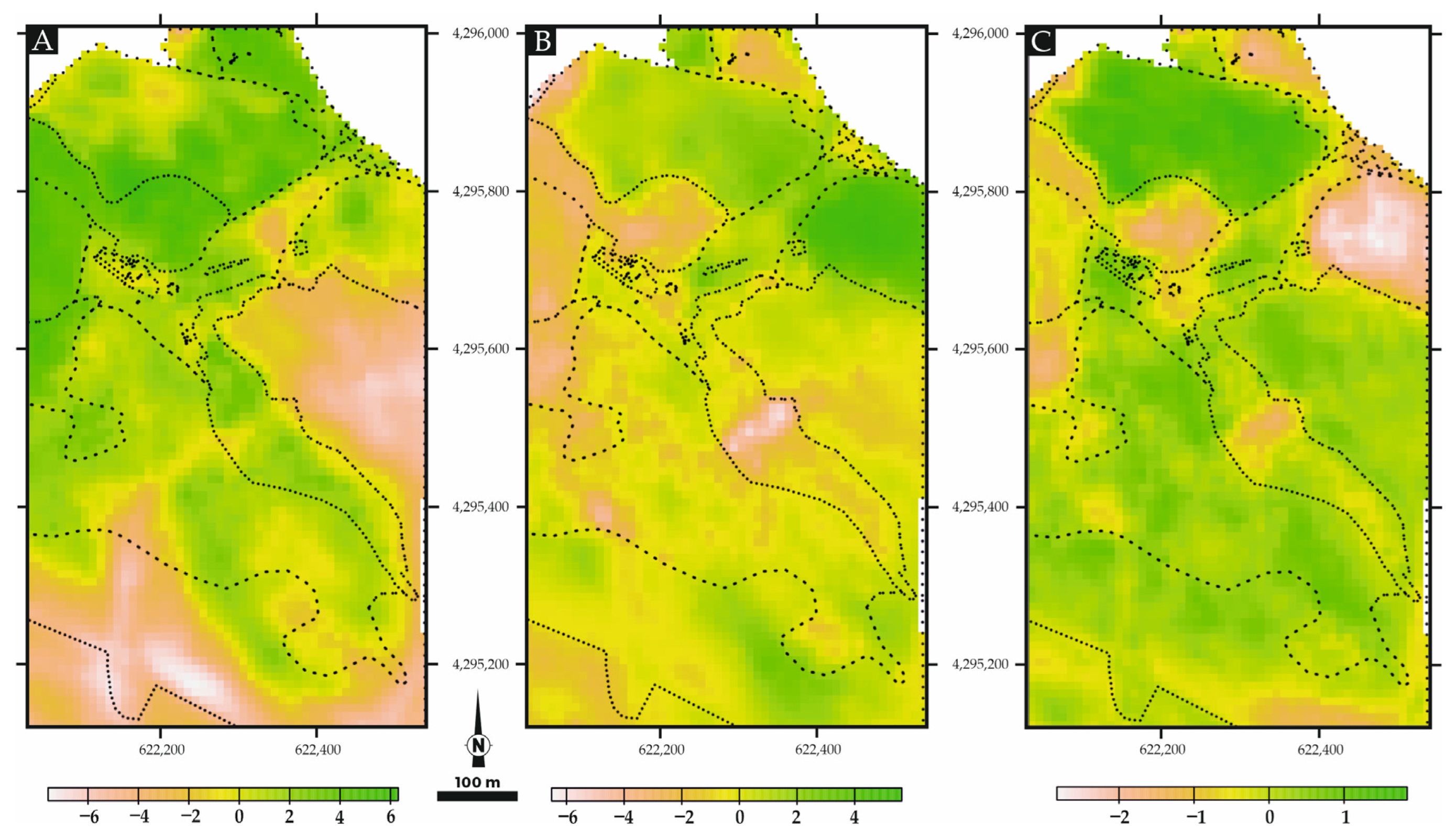
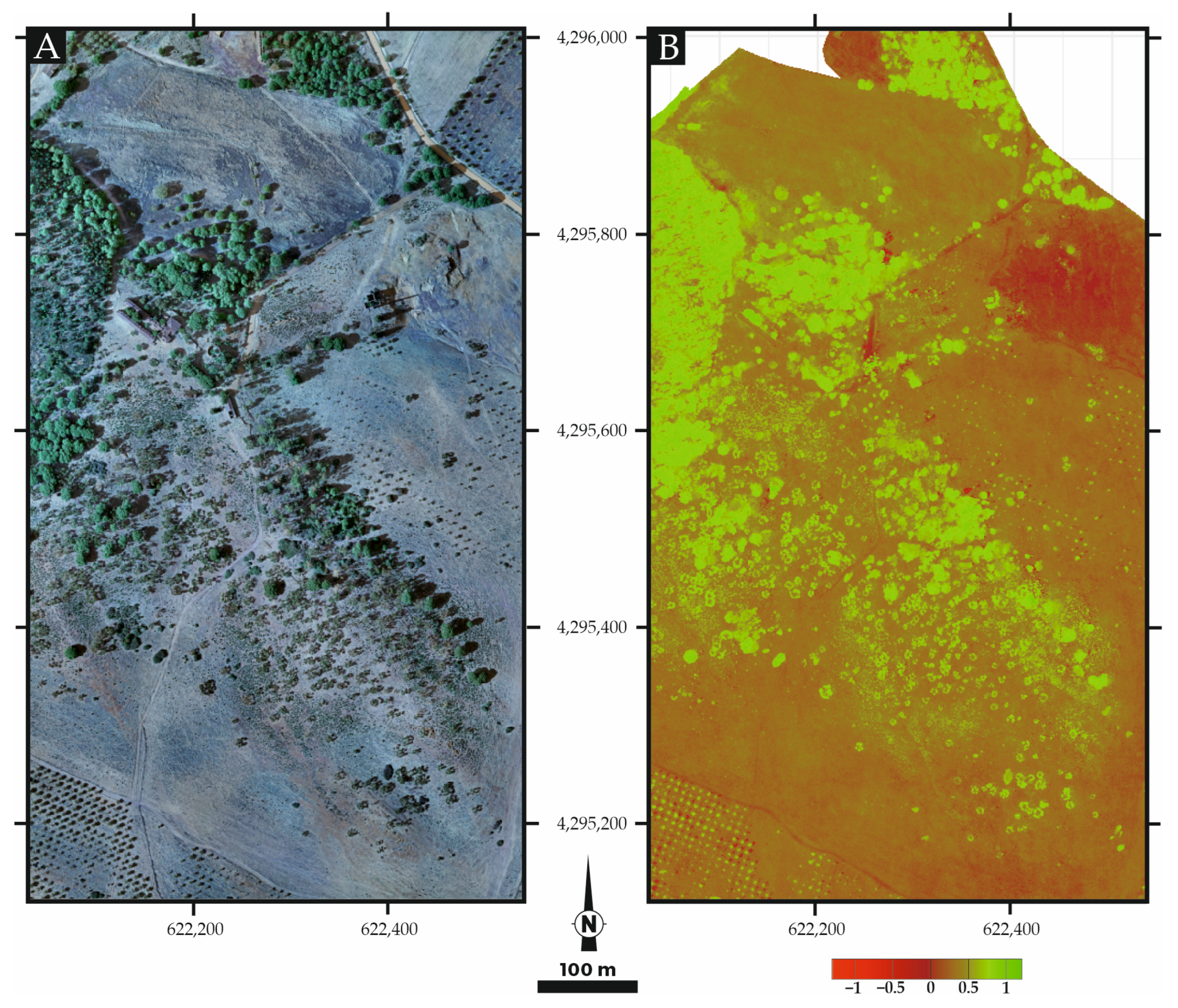
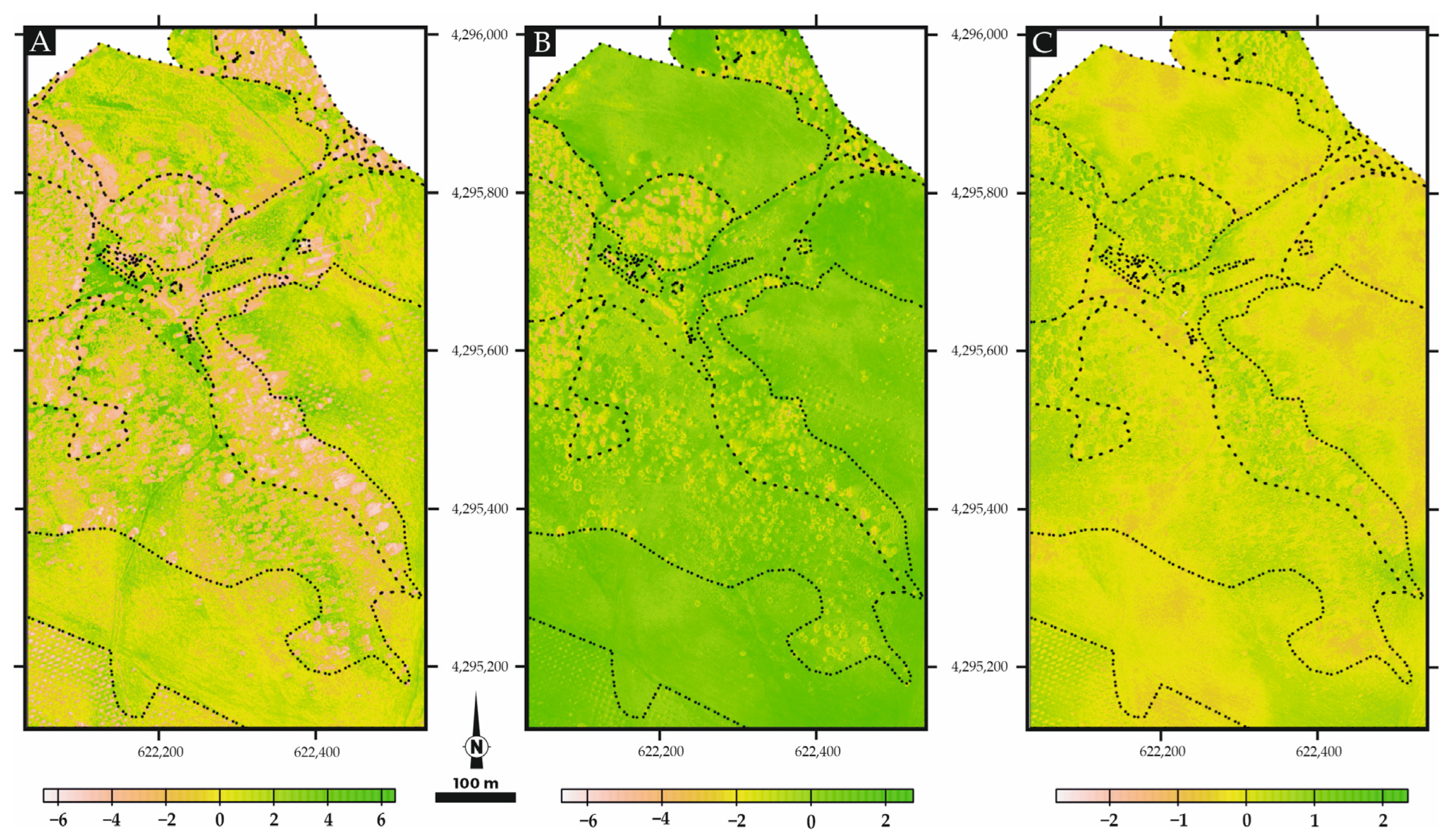
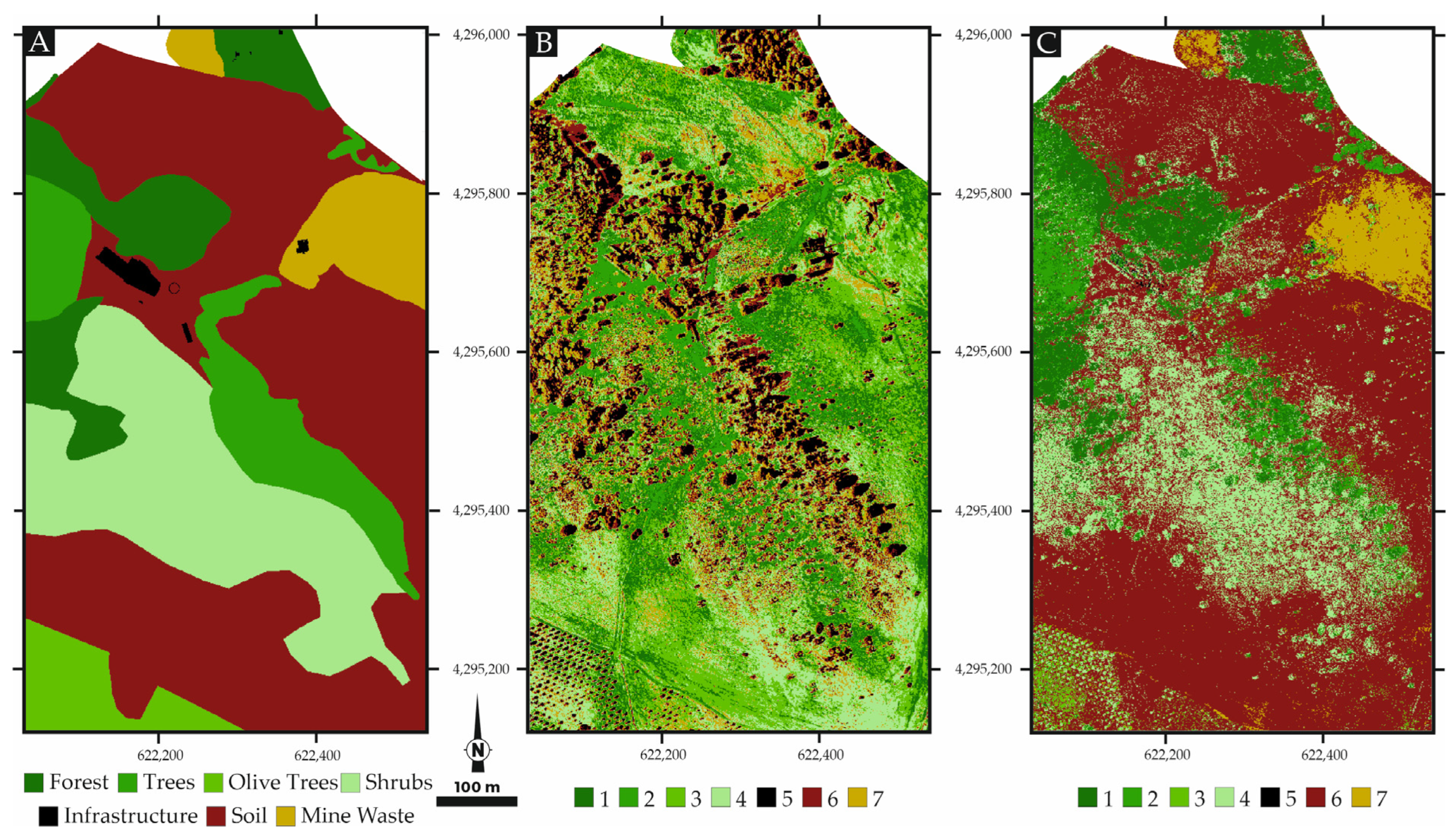
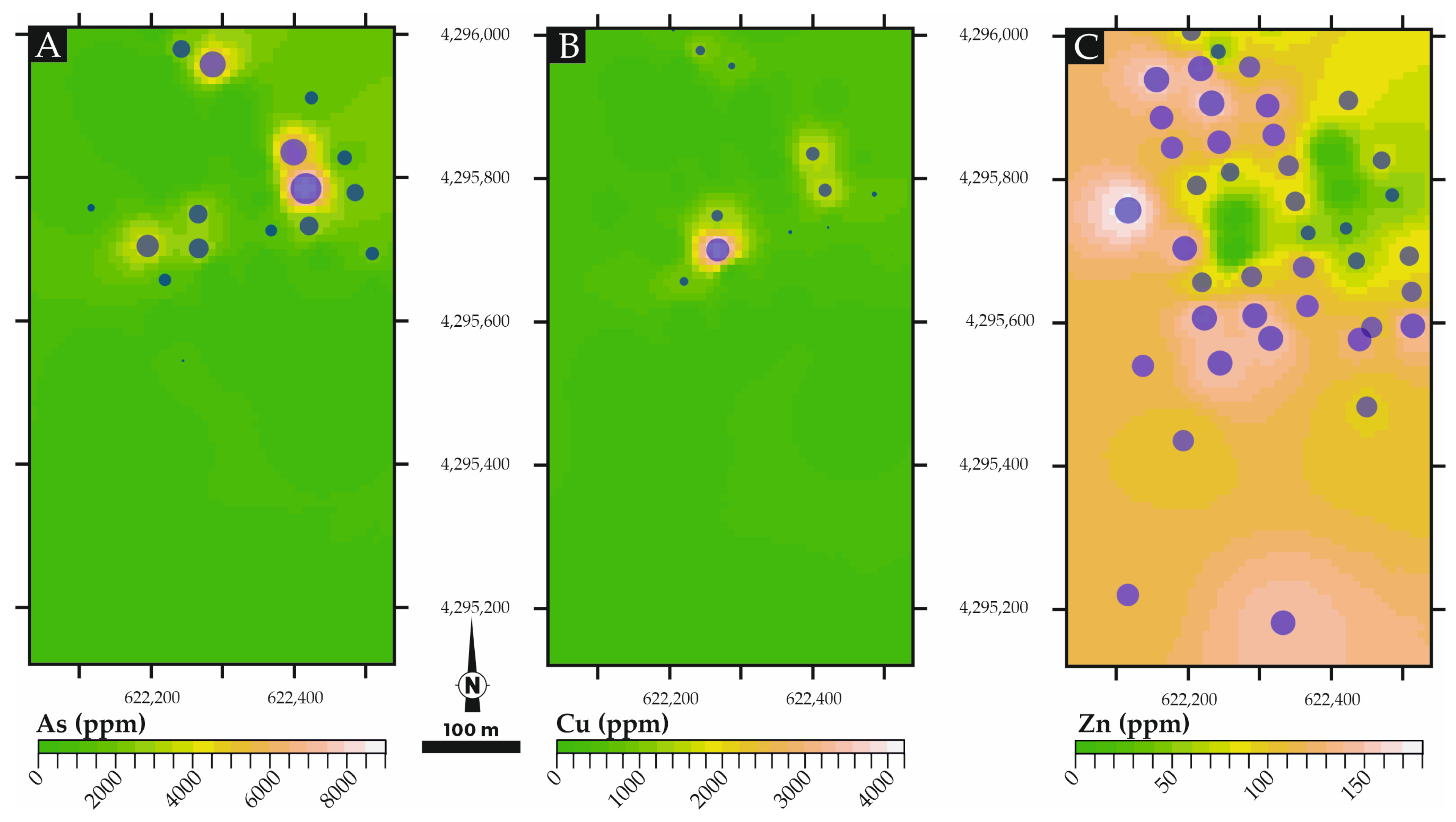
| Agricultural Soil | Mine Waste Soil | Bare Soil |
|---|---|---|
| P5, P14, P18, P19 | P1, P11, P12, P13, P16 | P4, P6, P7, P8, P9 |
| P23, P28, P29, P30, P38 | P17, P20, P21, P22, P24 | P10, P15 |
| P39, P40, P44, P45, P46 | P25, P26, P27 | P42, P43 |
| P48, P49, P50 | P31, P32, P33, P34, P35 | |
| P36, P37, P47 |
| Element 1 | APA | Mean | sd | Median | Skew | Kurtosis | Min | Max |
|---|---|---|---|---|---|---|---|---|
| Fe | 4.08 | 3.37 | 3.13 | 3.74 | 19.31 | 0.71 | 28.72 | |
| As | 18 | 1239 | 1974 | 257 | 2 | 5 | 46 | 10,057 |
| Co | 22 | 33 | 44 | 20 | 5 | 26 | 5 | 375 |
| Cr | 160 | 68 | 65 | 56 | 3 | 18 | 0 | 491 |
| Cu | 180 | 435 | 690 | 174 | 4 | 16 | 43 | 4960 |
| Mn | 727 | 449 | 581 | 2 | 12 | 152 | 3867 | |
| Ni | 130 | 54 | 23 | 50 | 2 | 4 | 7 | 158 |
| Pb | 45 | 84 | 72 | 62 | 4 | 23 | 32 | 664 |
| V | 86 | 134 | 30 | 140 | −2 | 7 | 0 | 174 |
| Zn | 340 | 98 | 49 | 99 | 0 | 0 | 0 | 253 |
| Band | Mean | sd | Median | Skew | Kurtosis | Min | Max |
|---|---|---|---|---|---|---|---|
| X1 (400) | 0.09 | 0.06 | 0.06 | 1.35 | 0.80 | 0.03 | 0.27 |
| Blue (490) | 0.15 | 0.09 | 0.12 | 1.33 | 0.85 | 0.06 | 0.44 |
| Green (560) | 0.23 | 0.12 | 0.19 | 1.26 | 0.79 | 0.08 | 0.62 |
| Red (665) | 0.31 | 0.15 | 0.26 | 1.45 | 2.23 | 0.10 | 0.88 |
| X2 (800) | 0.34 | 0.13 | 0.30 | 0.74 | −0.50 | 0.13 | 0.63 |
| NIR (840) | 0.35 | 0.13 | 0.31 | 0.71 | −0.51 | 0.13 | 0.64 |
| Spectrum Title | Description |
|---|---|
| Clinozoisite Epidote HS299 | The sample contains some epidote and quartz impurities. The sample probably contains some Mn3+ and Fe3+ substituting for its aluminum, which would explain its reddish-brown color |
| Hematitic Alt. Tuff CU91-223 | Hematitically altered rhyolite tuff from the relict eastern hydrothermal center at Cuprite, NV. Sample was collected from the northwest part of the eastern center. |
| Sand DWO-3-DEL2ar1 no oil | The area measured is at the end of the Mississippi river delta, an area known as the Bird’s Foot. This spectrum is the average reflectance (using an artificial light source) of bare sand that appeared to be oil-free. |
Disclaimer/Publisher’s Note: The statements, opinions and data contained in all publications are solely those of the individual author(s) and contributor(s) and not of MDPI and/or the editor(s). MDPI and/or the editor(s) disclaim responsibility for any injury to people or property resulting from any ideas, methods, instructions or products referred to in the content. |
© 2023 by the authors. Licensee MDPI, Basel, Switzerland. This article is an open access article distributed under the terms and conditions of the Creative Commons Attribution (CC BY) license (https://creativecommons.org/licenses/by/4.0/).
Share and Cite
Nogueira, P.; Silva, M.; Roseiro, J.; Potes, M.; Rodrigues, G. Mapping the Mine: Combining Portable X-ray Fluorescence, Spectroradiometry, UAV, and Sentinel-2 Images to Identify Contaminated Soils—Application to the Mostardeira Mine (Portugal). Remote Sens. 2023, 15, 5295. https://doi.org/10.3390/rs15225295
Nogueira P, Silva M, Roseiro J, Potes M, Rodrigues G. Mapping the Mine: Combining Portable X-ray Fluorescence, Spectroradiometry, UAV, and Sentinel-2 Images to Identify Contaminated Soils—Application to the Mostardeira Mine (Portugal). Remote Sensing. 2023; 15(22):5295. https://doi.org/10.3390/rs15225295
Chicago/Turabian StyleNogueira, Pedro, Marcelo Silva, José Roseiro, Miguel Potes, and Gonçalo Rodrigues. 2023. "Mapping the Mine: Combining Portable X-ray Fluorescence, Spectroradiometry, UAV, and Sentinel-2 Images to Identify Contaminated Soils—Application to the Mostardeira Mine (Portugal)" Remote Sensing 15, no. 22: 5295. https://doi.org/10.3390/rs15225295
APA StyleNogueira, P., Silva, M., Roseiro, J., Potes, M., & Rodrigues, G. (2023). Mapping the Mine: Combining Portable X-ray Fluorescence, Spectroradiometry, UAV, and Sentinel-2 Images to Identify Contaminated Soils—Application to the Mostardeira Mine (Portugal). Remote Sensing, 15(22), 5295. https://doi.org/10.3390/rs15225295







